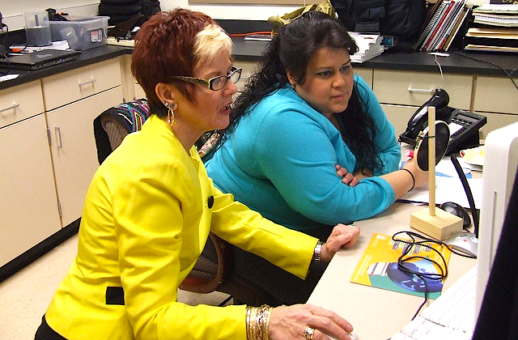Co-Teaching Cultivates Our Critical Thinking
A MiddleWeb Blog

We have known for over a decade now that we must be teaching our students how to think – how to learn, and how to value their thinking while keeping their minds open to various perspectives.
We have known for over a decade that our school system must evolve with the times – teachers are facilitators of learning rather than just disseminating information to a class filled with passive listeners.
It’s all about building relationships, creating a buzz about content area knowledge and strategies within a co-created learning community.
Critical Thinking and Students
Designing instruction that fosters critical thinking skills is a necessary part of our instructional process. We must make sure to proactively differentiate the learning to guide our students through a variety of levels of understanding.
- Bloom’s Taxonomy has stood the test of time to empower our own thinking and reflective practices. Specifically the revised taxonomy and questioning techniques continue to guide teachers to evolve with the times to support learning through carefully designing and meaningful active learning for everyone.
- Check out Literacy is Not Enough to think about applying the important skills of problem solving, creativity, collaboration, analytical thinking, ethics, action, and accountability (Crockett, Jukes, & Churches, 2011).
Now let’s make a shift. Think about how critical thinking skills could transform the process of co-teaching!
Let’s take a few mindful moments to realize the opportunities for your own critical thinking evolution.
Critical Thinking and Co-Teachers
Have you noticed how many opportunities exist for co-teachers to develop their own critical thinking skills? There are many ongoing job-embedded experiences that promote our own professional growth.
- Reciprocal lesson planning reflections. Seeing a lesson from two perspectives combines the expertise of two teachers who can empower the talents of one another through ongoing collaborations. Co-teachers can develop a deeper sense of self-confidence through peer feedback. Through reciprocal, open-minded reflections, co-teachers can expand their understanding and applications of effective instructional strategies.
- Developing a mutual sense of presence. Co-teachers can think critically about their instructional decisions and teaching moves within the actual moments of being with students. Each teacher can support the purposeful awareness and observations of students’ behaviors. The process of instruction is a give and take between two co-teachers, which allows each teacher to become deeply aware of how students are responding and performing within the moments of instruction.
- Broadening one another’s knowledge base: Co-teachers have so much to learn from one another. Each teacher can support the learning process by expanding content knowledge and selecting strategic applications to invigorate the process of learning. Be open to learning and sharing – while modeling a true process of learning with your students.
- Resilient collaborations: Co-teaching sets up the optimal experience to think critically about many aspects of teaching. When there are disagreements, resiliency paves the way, helping us keep an open mind about new ways of teaching a lesson, assessing student learning, and managing the class routines. The possibilities are completely endless – if we allow them to be!
As you and your co-teacher proactively plan for developing the critical thinking skills with your students, take a minute to notice how you can support critical thinking and deeper learning for one another too.
In fact, take a second now to think about how you are already developing your own critical thinking skills—and share in the comments section below. Let’s get this conversation started!




































As a special education teacher at the middle school level, I frequently was called upon to support students in mainstream classes within the classroom. One of the techniques I found very useful was to ask the questions that students did not ask for fear of admitting their confusion. Since almost everyone has experienced those times when their understanding was less than complete, it helped to create an atmosphere that said asking questions was not a sign of failure. Those questions actually help a good teacher clarify concepts that may need to be approached from a different angle to reach all the students.